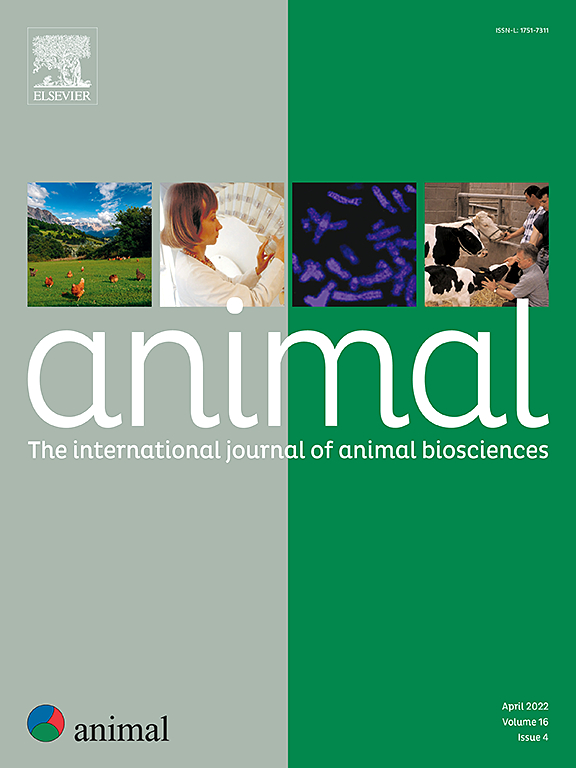气候适应能力在欧洲奶羊种群中有所不同
IF 4.2
2区 农林科学
Q1 AGRICULTURE, DAIRY & ANIMAL SCIENCE
引用次数: 0
摘要
欧洲奶羊行业的特点是品种繁多,环境多样,存在完善的选择方案。本研究的目的是在种群和个体水平上描述欧洲奶牛品种对热负荷(TL)变化的生产反应。采用Assaf (As)、Chios (Ch)、Lacaune (Lc)、Latxa (Lt)和Manchega (Mn) 5个奶牛品种的乳、脂肪和蛋白质试验日产量数据。总共有来自827个羊群的68972只母羊参与了这项研究。这些品种在原产地和繁殖区有不同的气候,从温带(Lc和Lt)到温暖(As, Ch, Mn),在选择程序的强度上,As和Lc的选择更强烈。历史生产数据与记录当日的气象资料相结合。在混合模型设置下,用多项式函数拟合反应范数模型。观察到不同品种的种群对TL变化的反应存在很大差异。在生产水平和气候条件相似的情况下,Mn和Ch对冷的敏感性大于对热的敏感性。另一方面,Lt品种对冷胁迫的耐受性最高,对热的敏感性中等。产量最高的品种As和Lc对冷(CS)或热(HS)胁迫表现出最大的敏感性,As/Lc在冷/热胁迫下的产量损失最大。在两个极端情况下,所有品种对热应激的反应都存在个体差异。然而,响应斜率的变异性远低于性状的总体变异性,在Lc品种中,所有性状在CS下的变异性为4%/°C,而在HS下的脂肪产量变异性为17%/°C。在所有品种中,这些性状的个体水平与耐热性呈负相关,表明高产与耐热性之间存在拮抗关系。然而,这种拮抗作用在Mn中是轻微的(奶产量为- 0.19,脂肪和蛋白质产量为- 0.28),在Lc中最大(奶、脂肪和蛋白质产量分别为- 0.77,- 0.96和- 0.70)。考虑到与气候变化相关的预期温度升高,以不适应温暖条件的品种为基础的奶羊养殖以及以高产动物为基础的集约化系统,将需要实施减热战略或在选择计划中纳入耐热性,以提高未来的适应能力。本文章由计算机程序翻译,如有差异,请以英文原文为准。
Climate resilience differs across dairy sheep populations in Europe
The dairy sheep sector in Europe is characterised by the wide range of breeds involved, the variety of environments and the existence of well-established selection schemes. The goal of this study was to characterise the productive response to changes in thermal load (TL) across dairy sheep breeds in Europe, both at the population and the individual levels. Milk, fat and protein test day yields data from five dairy breeds, Assaf (As), Chios (Ch), Lacaune (Lc), Latxa (Lt) and Manchega (Mn) were used. Overall, 682 972 ewes from 827 flocks participated in the study. The breeds differed in the climatic region of origin and breeding area, varying from temperate (Lc and Lt) to warm (As, Ch, Mn), and, in the intensity of the selection programmes, with As and Lc more intensely selected. Historical production data were combined with meteorological information at the date of recording. Reaction norm models with polynomial functions in mixed model settings were fitted. Substantial variability in the population response to changes in TL was observed across breeds. Mn and Ch, with similar levels of production and climatic conditions, displayed greater sensitivity to cold than to hot conditions. On the other hand, the Lt breed showed the highest tolerance to cold stress and was moderately sensitive to heat. The most productive breeds, As and Lc, showed the largest sensitivity to cold (CS) or heat (HS) stress, with As/Lc showing the greatest production loss associated with cold/heat stress. Individual variability in response to thermal stress was observed in all breeds for the two extremes. However, variability in slopes of response was substantially lower than the overall variability of the trait, ranging from 4%/°C for all traits under CS to 17%/°C for fat yield under HS, in the Lc breed. For all breeds, a negative correlation was estimated between the individual level of the traits and heat tolerance, indicating antagonism between high production and heat tolerance. However, this antagonism was mild in Mn (−0.19 or milk yield and −0.28 for fat and protein yield) and largest for Lc (−0.77, −0.96 and −0.70 for milk, fat and protein yields, respectively). Given the expected increase in temperatures associated with climate change, dairy sheep farming based on the breeds less adapted with warm conditions and also for the more intensive systems based on highly producing animals will need to implement heat abatement strategies or incorporate heat tolerance in the selection programmes to improve future adaptation.
求助全文
通过发布文献求助,成功后即可免费获取论文全文。
去求助
来源期刊

Animal
农林科学-奶制品与动物科学
CiteScore
7.50
自引率
2.80%
发文量
246
审稿时长
3 months
期刊介绍:
Editorial board
animal attracts the best research in animal biology and animal systems from across the spectrum of the agricultural, biomedical, and environmental sciences. It is the central element in an exciting collaboration between the British Society of Animal Science (BSAS), Institut National de la Recherche Agronomique (INRA) and the European Federation of Animal Science (EAAP) and represents a merging of three scientific journals: Animal Science; Animal Research; Reproduction, Nutrition, Development. animal publishes original cutting-edge research, ''hot'' topics and horizon-scanning reviews on animal-related aspects of the life sciences at the molecular, cellular, organ, whole animal and production system levels. The main subject areas include: breeding and genetics; nutrition; physiology and functional biology of systems; behaviour, health and welfare; farming systems, environmental impact and climate change; product quality, human health and well-being. Animal models and papers dealing with the integration of research between these topics and their impact on the environment and people are particularly welcome.
 求助内容:
求助内容: 应助结果提醒方式:
应助结果提醒方式:


